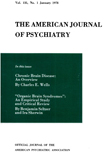Auditory Evoked Response, EEG, and Thought Process in Schizophrenics
Abstract
The authors investigated the clinical symptomatology, auditory evoked responses, and quantitatively analyzed EEGs of chronic schizophrenic patients with thought process disorder (TPD), schizophrenic patients without TPD, and matched normal volunteers. They describe the differences they found in terms of the variability, shape, latency, and amplitude of the patterns of the evoked potentials for the three groups. They also attempt to relate the neurophysiological findings with some characteristics of thought process disorder.
Access content
To read the fulltext, please use one of the options below to sign in or purchase access.- Personal login
- Institutional Login
- Sign in via OpenAthens
- Register for access
-
Please login/register if you wish to pair your device and check access availability.
Not a subscriber?
PsychiatryOnline subscription options offer access to the DSM-5 library, books, journals, CME, and patient resources. This all-in-one virtual library provides psychiatrists and mental health professionals with key resources for diagnosis, treatment, research, and professional development.
Need more help? PsychiatryOnline Customer Service may be reached by emailing [email protected] or by calling 800-368-5777 (in the U.S.) or 703-907-7322 (outside the U.S.).



